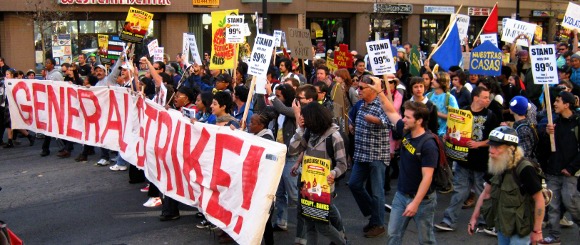
I’d been feeling kind of guilty about not participating in any of the Occupy events, and having a hard time putting a finger on the reasons for my reluctance. After all, might this be something like the “we’re finally fed up”-rising I’ve been hoping for?
In , as you’re probably already aware, groups of people from a number of area law enforcement agencies tried to destroy the Occupy Oakland gathering. They fired a variety of projectiles at the crowd, including tear gas and flash-bang grenades — in one case, striking an Iraq vet in the head with enough force to hospitalize him with brain damage, then tossing a flash-bang grenade into the group of people who had come to his aid.
The result of all of this is that the city of Oakland and its new mayor (the darling of Oakland’s progressive voters in the last election) got a black eye, and the occupation came back stronger than ever. The occupation’s 1,607-person “general assembly,” operating on a supermajority-voting modified consensus-style process, decided to up the ante by calling for what it called a “general strike” to take place today.
The strike proposal called on people to “liberate Oakland and shut down the 1%” by joining the strike, and threatened to march on “banks and corporations” that failed to honor the strike by closing their doors for the day. It further encouraged people to organize on their own initiative to “participate in shutting down the city.”
I got downtown at about . I believed the hype enough that I packed a lunch, figuring everything might be closed down. Not so much. Some businesses were closed, but many others, even ones close to the Occupy Oakland encampment, were still operating.
There were a few thousand people gathered at an intersection of Broadway, listening to an amplified speaker. The mood was festive. At one point, a hundred or so people broke into a synchronized dance as someone sang a protest song to the tune of “I Will Survive.” The speakers were not doctrinaire and didn’t seem to be trying to make themselves out to be the leaders, which was a refreshing contrast to the ANSWER-style anti-war rallies. One speaker noted that the general assembly had also passed a resolution encouraging people to occupy or otherwise appropriate abandoned or foreclosed buildings. Another encouraged people to move their own bank accounts into credit unions on .
The encampment had a fresh layer of straw down under it, and was ringed by booths, including a library of sorts, a compost collection area, and a food tent. A number of publishers and booksellers of various socialist persuasions had set up lit tables, and the IWW were silkscreening propaganda messages in black beans onto tortillas and handing them out (neat trick). There were several shrines to Scott Olsen, the vet who was shot during the police raid on the encampment.
It reminded me a lot of the protests I’d seen in Mexico, which seem commonly to take the form of people camping out for a period of time in the zócalo.
If I were to try to distill the message of the crowd — the signs they carried, the speakers they cheered, the chants they chanted — it’d come down to something like this: “Why the hell should we play by the rules when the rich and powerful all have their thumbs on the scales — it’s our turn now, there are more of us than you, and we’ll take what we can get because we’re sick of getting played.” There wasn’t much patience for nuance or well-thought-through policy proposals: mostly just a feeling that the haves mostly got theirs unfairly, and so the have-nots have every right to demand it back.
That said, chants and signs and exhortations from speakers are necessarily oversimplified things, so it should be no surprise that any message you can distill from them will itself be oversimplified.
The rally became a short march, doing a loop around several blocks of the downtown area. There was much talk of “shutting down” Oakland or the 1%, but really the march was just a parade. It marched past the state and federal government buildings without stopping to do anything there, and eventually circled back to its starting place. Some people plastered posters on the doors of a Wells Fargo branch that had wisely been closed for the day; a crowd rallied outside a Comerica bank branch across the street that hadn’t been so wise (they quickly locked the doors).
Some time after I left, the glass-breaking fetishist fringe smashed some windows at the Wells Fargo branch and some other businesses that failed to heed the strike call. For the most part, though, the rally was overwhelmingly nonviolent, and the police presence was very light: except for some police in the subway station and a handful of guards inside the doors of the government buildings, I didn’t see any uniforms at all. That changed as the window-smashers showed up, and as night fell, the police presence at the Port of Oakland increased.
By late-afternoon, the rally had moved from downtown to the Port of Oakland, which the marchers blockaded (“Maritime operations at the port are effectively shut down,” a port authority spokesman said around ). Rumor had it that the Occupy San Francisco crowd had decided to march across the Bay Bridge (which normally has no pedestrian access) to join them, but I didn’t see any evidence of that.
So, yeah, that’s where it stands as of now. A general strike it wasn’t, though it was a big bunch of people being pissed off together, making law enforcement more expensive, and shutting down a major port for a while.
